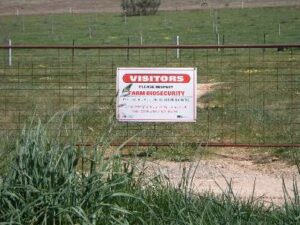Read the latest information on
Foot-and-mouth disease
Biosecurity is a shared responsibility. Everyone who participates in an agricultural supply chain has some biosecurity responsibility. A common concern among producers is that an adjoining neighbour may lack good biosecurity – and no one wants to be THAT neighbour!

The most common point of tension between neighbours results from inadequate fencing which fails to keep livestock within property boundaries.
“Maintaining good boundary fencing is one of the easiest ways to protect your property and business from a disease incursion. Good boundary fencing keeps your livestock in and stray livestock out,” says AHA Extension Manager, Dr Sophie Hemley.
“If you are concerned about stray animals and the biosecurity risk they pose, consider a double fence line around your boundaries, particularly in high-risk locations.”
It is the owner’s responsibility to ensure animals stay within their boundary. To do this it is important to maintain fences and provide adequate feed and water, but it is inevitable that some animals will jump or push through fences.
“Devise a ‘stray animal plan’ with your neighbour and include this in your biosecurity plan. Make sure to clearly identify what you will do if you find your neighbour’s animals on your property, how they will be returned and vice versa,” says Dr Hemley.
Producers should also consider their neighbour’s enterprise risk score: a neighbour that has a closed flock or herd and has not introduced any new animals onto the property in the past 12 months poses a lower risk than a neighbour who purchases livestock without consideration of their health status, or has recently received a positive test for a disease such as Johne’s disease.
If you are lucky enough to live in an area where all the neighbours are proactive about biosecurity why not consider establishing a biosecurity group? These groups give neighbours an opportunity to discuss and create solutions for common concerns and there is much to be gained from collaborating. Another idea is to host technical experts (your local vet for example) to help you update your biosecurity plan and ensure all your neighbours are doing the same.
At the end of the day, biosecurity is everyone’s responsibility. Upholding your biosecurity responsibilities and having a good relationship with your neighbours can help to safeguard your property and local area from serious pest, weed and disease incursions. Above all else, just don’t be THAT neighbour!